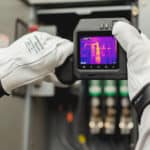Let’s talk about keeping your business engine humming smoothly. Asset reliability isn’t just important—it’s the backbone of seamless operations. Picture this: reliable equipment means no sudden stops, no frustration, and no draining of your team’s time and energy. So, how do you keep that reliability top-notch? Well, that’s where condition monitoring comes in to save the day.
Streamline Operations with Condition Monitoring
Think of condition monitoring as your equipment’s health tracker. It’s all about keeping a constant eye on how things are running. This means spotting any sneaky issues before they blow up into big headaches.
With proper technology, condition monitoring can detect even the tiniest hiccups in equipment performance. And trust us, catching problems early is a game-changer. With these insights, your team can tackle issues head-on, keeping your operations smooth sailing.
Because let’s face it, in the business world, time is money. And with condition monitoring by your side, you’re not just saving time—you’re protecting your bottom line and keeping your competitive edge sharp. So, why wait? Let’s keep those operations running like a well-oiled machine.
The Benefits of Condition Monitoring
Bringing effective condition monitoring processes into your operations isn’t just a smart move—it’s a game-changer for your organization’s asset reliability. Here’s why it matters:
Early Detection of Equipment Issues
Imagine having a team of vigilant technicians keeping a watchful eye on your assets. With condition monitoring, that’s precisely what you get. They swiftly catch any signs of trouble before they spiral into significant breakdowns, keeping operations running smoothly and everyone’s stress levels in check.
Savings on Maintenance Costs
Nobody likes surprise expenses, especially when they come from emergency repairs. Condition monitoring helps you dodge those costly surprises by addressing problems before they snowball. That means fewer late-night repair calls and more money saved for the things that matter to your organization.
Finding Ways to Improve
Think of condition monitoring as a magnifying glass for your equipment. It helps you zoom in on areas that need extra attention, empowering your maintenance team to fine-tune schedules and stock up on spare parts. With everything running like a well-oiled machine, you’ll wonder how you ever did without it.
Getting the Most Out of Your Assets
We all want to get the most bang for our buck. With condition monitoring, you’re not just prolonging the life of your assets—you’re squeezing every last drop of performance out of them. That means increased productivity and fewer headaches for you and your team.
Smarter Maintenance Strategies
Thanks to condition monitoring, you’re no longer flying blind regarding maintenance. You’ve got the data you need to make informed decisions, fine-tune your strategies, and focus your efforts where they’ll have the most significant impact. It’s like having a personal coach guiding you to victory.
Whether you’re looking to save money, boost efficiency, or sleep better at night, condition monitoring has got you covered. It’s not just a tool—it’s a partner in your organization’s success.
Adding Condition Monitoring to Your Maintenance Plan
When it comes to weaving condition monitoring into your maintenance strategies, think of it like a recipe—each step is essential for a delicious outcome:
- Take Stock of What You’re Doing Now: Look at how you currently handle maintenance. What’s working well? Where could you use a little extra help?
- Spotlight Your MVPs: Determine which assets are your operation’s real MVPs. Monitor them closely to ensure smooth operation.
- Choose Your Tools Wisely: Like a chef, pick the proper utensils and select the best asset monitoring techniques. Whether vibration analysis or thermal imaging, ensure you use the right tools.
- Set Up a Check-in Schedule: Develop a plan for regular check-ins with your assets. This schedule should be based on their criticality and any risks they might face.
- Keep Your Eyes Peeled: Now it’s time to implement your plan. Monitor your assets, collecting and analyzing data regularly for any signs of trouble.
- Make Maintenance Moves: Use the insights you gather to make smart maintenance decisions. Let your data guide you, whether it’s tweaking schedules, prioritizing repairs, or planning for replacements.
- Equip Your Team: Ensure your maintenance crew knows how to use your monitoring tools effectively. Provide them with the training and resources they need to keep things running smoothly.
- Always Be Improving: Review and refine your monitoring program regularly. Listen to feedback, track performance, and look for ways to improve.
These steps will keep your assets in top shape and ensure your maintenance efforts are as efficient and effective as possible.
Your Go-To Ally for Reliable Assets
So there you have it, the ultimate power duo: condition monitoring and asset reliability. Working hand in hand to keep your business firing on all cylinders.
By teaming up with condition monitoring, you’re not just preventing downtime and saving on maintenance costs. You’re also taking a proactive approach to keep your equipment in tip-top shape and tapping into valuable data insights to guide your decisions.
At SEAM Group, we’re not just experts in condition monitoring—we’re your partners in success. Together, we’ll dial in your maintenance strategies to boost performance and keep your equipment running like clockwork. Let’s team up and take your business to the next level!





